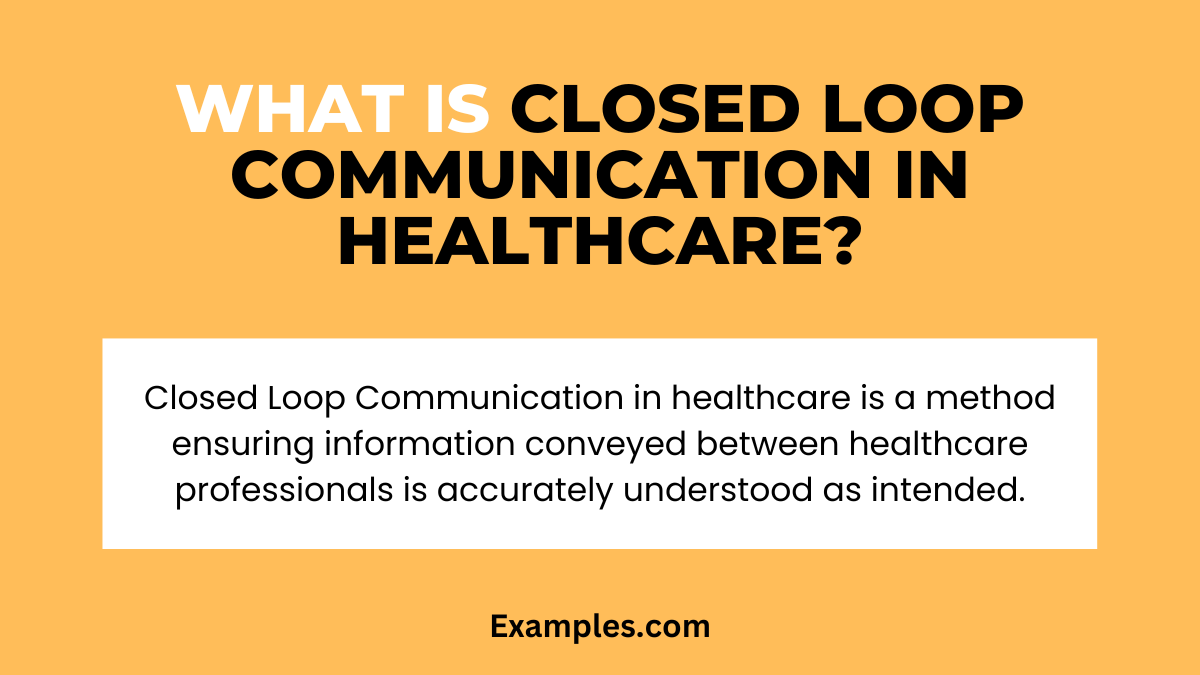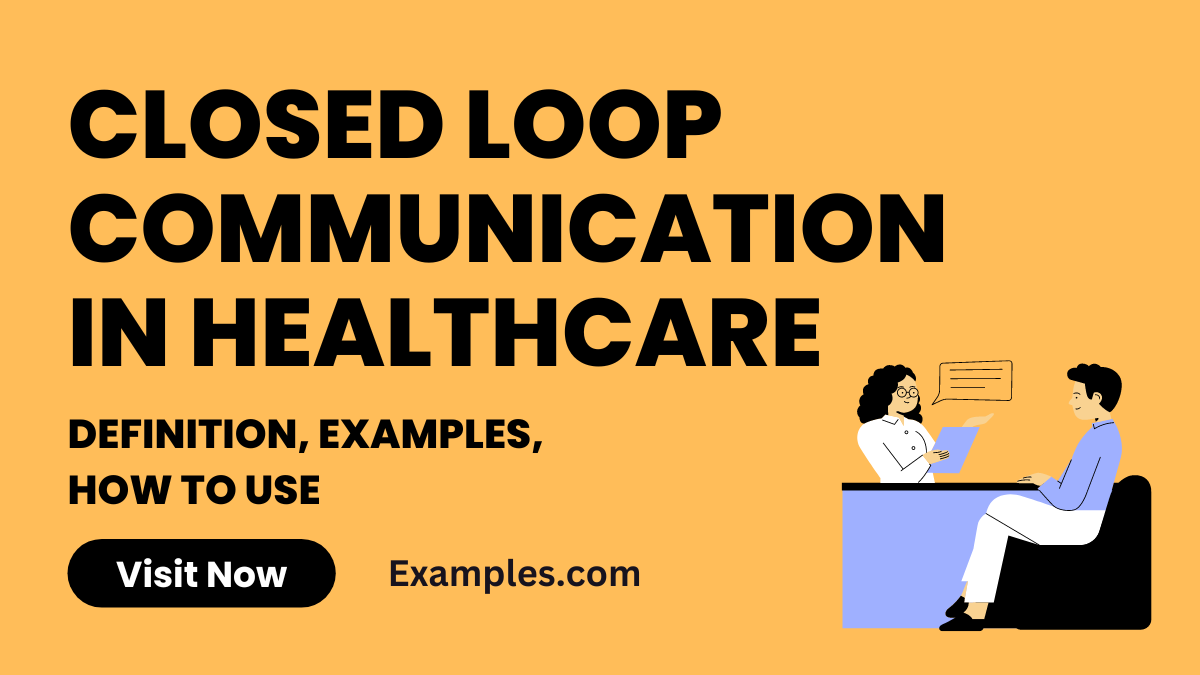19+ Closed Loop Communication in Healthcare Examples
Closed Loop Communication in healthcare is a pivotal communication strategy ensuring clarity, accuracy, and patient safety. This guide delves into its essence, illustrating how this method minimizes medical errors and bolsters healthcare quality. Through real-world examples, we highlight its significance in various healthcare settings, from routine patient care to critical medical procedures. Understanding Closed Loop Communication is crucial for healthcare professionals, as it fosters effective information exchange, reinforces patient care protocols, and enhances team coordination. This comprehensive guide serves as a resource for healthcare providers seeking to adopt and refine this essential communication practice.
What is Closed Loop Communication in Healthcare? – Meaning

Closed Loop Communication in healthcare is a method ensuring information conveyed between healthcare professionals is accurately understood as intended. This communication model involves three key steps: the sender gives a message, the receiver repeats or “reads back” the message, and the sender confirms the accuracy of the response. This process, a vital component of patient safety protocols, significantly reduces misunderstandings and medical errors. It’s a core aspect of healthcare communication, encompassing essential actions to maintain clarity and precision in critical environments. Understanding and implementing What is Closed Loop Communication and its Essential Actions for Closed Loop Communication can significantly reduce medical errors and improve patient outcomes.
Download Closed Loop Communication in Healthcare in PDF
20 Closed Loop Communication in Healthcare Examples

Closed Loop Communication in healthcare is a vital tool for ensuring accurate and effective communication between healthcare providers and patients. This method involves a series of steps that include the initiation of a message, acknowledgment by the receiver, and confirmation by the sender to ensure accurate understanding. This approach is crucial for enhancing patient safety and preventing medical errors. The importance of Closed Loop Communication in healthcare cannot be overstated, as it is fundamental in avoiding misunderstandings and ensuring high-quality patient care. Implementing Closed Loop Communication Steps systematically in healthcare settings can significantly reduce the risk of errors and improve overall communication effectiveness.
- During Surgery: A surgeon requests a specific instrument and the nurse repeats the request before handing it over, ensuring the right tool is provided.
- Medication Administration: A nurse reads back a doctor’s medication order to confirm dosage and medication type, preventing medication errors.
- Emergency Situations: In an emergency, a doctor’s instructions are repeated by the team, confirming that everyone understands the plan of action.
- Patient Handovers: During shift changes, nurses use closed loop communication to confirm patient care details, ensuring continuity of care.
- Lab Results Communication: A doctor communicates lab result requests, and the receiving staff repeats the specifics to confirm accuracy.
- Radiology Orders: Radiologists confirm the type of scan requested by the physician through repeating back the order.
- Patient Discharge: Instructions given to a patient upon discharge are repeated back by the patient or family member for clarity.
- Telephonic Orders: Nurses repeat telephonic orders from physicians to confirm the details are correct.
- Critical Test Results: When communicating critical test results, the receiving healthcare professional repeats the results to the sender.
- Allergy Checks: Before administering medication, healthcare providers confirm the patient’s allergies by repeating them back.
- Blood Transfusion: Before a blood transfusion, the type and quantity of blood are repeated back to confirm the order.
- Dietary Orders: Dietary instructions from a dietitian are repeated back by nursing staff.
- Physical Therapy Orders: Therapists confirm the prescribed exercises by repeating them back to the referring physician.
- Post-Operative Care Instructions: Post-operative care instructions are repeated back to ensure proper patient care.
- Ambulance Handovers: Paramedics repeat back patient details to hospital staff upon arrival.
- ICU Patient Monitoring: Changes in patient monitoring in ICU are confirmed through repeating back the instructions.
- Anesthesia Dosage: Anesthesiologists confirm the dosage of anesthesia by repeating it back to the surgical team.
- Patient Consent: Before procedures, patient consent is confirmed by having them repeat the details of the procedure.
- Follow-Up Appointments: Patients or family members repeat back appointment details to confirm understanding.
- Special Care Instructions: Any special care instructions, like wound care or mobility restrictions, are repeated back for clarity.
Why is Closed Loop Communication Important in Healthcare?
Closed Loop Communication is vital in healthcare as it ensures clarity and accuracy in the exchange of information. This communication method helps in reducing medical errors, enhancing patient safety, and improving overall care quality. By implementing Closed Loop Communication, healthcare providers can confirm that critical information, such as medication dosages or patient care instructions, is correctly understood and acted upon. This approach is essential in creating an environment of effective communication between healthcare professionals and patients, which is a cornerstone in providing safe and efficient healthcare.
What are Types of Closed Loop Communication in Healthcare?
In healthcare, Closed Loop Communication can take various forms:
- Verbal Closed Loop Communication: This method is characterized by spoken exchanges where a healthcare provider conveys a message, and the recipient repeats or paraphrases it back for confirmation.
- Written Closed Loop Communication: Involves the use of written communication, particularly crucial for maintaining patient records or medication charts.
- Digital Closed Loop Communication: Utilizes electronic tools like Electronic Health Records (EHRs) to facilitate accurate and traceable information exchange.
- Non-Verbal Closed Loop Communication: Relies on non-verbal cues like gestures or signals, especially useful in situations where verbal communication may be hindered, such as in noisy environments or when wearing masks.
These types are crucial in different healthcare settings, including Closed Loop Communication in Nursing, ensuring Closed Feedback Loop Communication, and enhancing the interaction between Closed Loop Communication for Patients and Nurses. Each form plays a significant role in ensuring effective and error-free communication in various medical contexts.
How to Use Closed Loop Communication In Healthcare?
Using Closed Loop Communication in healthcare involves a series of steps designed to ensure clear and accurate exchanges of information. This method is particularly crucial in Closed Loop Communication in Medical settings, where precise communication can be life-saving. The process includes initiating a message, ensuring the receiver acknowledges and understands it, and then having the sender confirm the accuracy of the receiver’s understanding. It’s a repetitive cycle that guarantees no part of the message is lost or misunderstood. Closed Loop Communication is a critical element in healthcare settings, enhancing clarity and minimizing the risk of errors. Here’s how to effectively implement it:
- Initiate with a Clear Message: Start each communication with a precise, unambiguous message. In a medical context, this could involve specific instructions about medication dosages or patient care procedures.
- Acknowledge and Repeat: The healthcare professional receiving the message should actively listen, acknowledge receipt, and then repeat or paraphrase the message to confirm their understanding.
- Seek Clarification: If there’s any doubt or uncertainty, it’s crucial for the receiver to ask questions. This step helps in clarifying any potential misunderstandings, ensuring that both parties are aligned.
- Confirm Understanding: The sender of the message should then confirm that the receiver’s repetition or paraphrase of the message is accurate, which is key to ensuring that there are no communication errors.
- Document the Communication: As an integral part of Closed Loop Communication in Medical, documenting the exchange in the patient’s medical records provides a written record that can be referenced later for continuity of care.
- Continuous Training: Regular training sessions and simulation drills can enhance the skills of healthcare staff in Closed Loop Communication.
Tips for Effective Closed Loop Communication in Healthcare
Here are the steps for effective Closed Loop Communication in healthcare:
- Start with Clear Instructions: Begin every patient interaction or team briefing with concise, straightforward instructions. This step is key to preventing misunderstandings right from the start.
- Encourage Acknowledgment: Promote a practice where the receiving party acknowledges by repeating or paraphrasing the instructions back. This ensures that the message has been properly received and understood.
- Foster a Culture of Clarity: Develop a workplace environment that encourages team members to seek clarification whenever necessary. This openness can significantly reduce communication errors.
- Utilize Technology: Leverage technology, such as electronic health records and communication tools, to aid and document the communication process effectively.
- Compare and Contrast: Understand the differences between Open Loop vs Closed Loop Communication to appreciate the benefits of the latter in healthcare settings.
For more information on Closed Loop Communication in healthcare, consider exploring detailed medical communication resources or healthcare guidelines.
What is a Closed Loop System in Healthcare?
A closed loop system in healthcare ensures accurate communication and action follow-up, enhancing patient safety and care efficiency.
What is Closing the Loop on Patient Care?
Closing the loop in patient care involves confirming and documenting communication and actions, ensuring nothing is overlooked or misunderstood.
What is Closed Loop Communication and CPR?
In CPR, closed loop communication is used for clear, precise instructions and responses, crucial for effective and timely life-saving actions.
How are Closed Loop Systems used in Daily Life?
Closed loop systems in daily life involve feedback and confirmation processes, used in various fields for effective communication and task completion.
Closed Loop Communication in healthcare is a vital strategy to enhance patient safety and reduce medical errors. This communication technique involves a sequence of steps to ensure accurate information transfer and understanding between healthcare providers.
In healthcare, Closed Loop Communication is employed in various scenarios, including patient care, medical procedures like CPR, and even during emergency situations. For instance, in CPR, this form of communication ensures that the instructions for life-saving actions are clearly understood and accurately executed.
One significant challenge in the implementation of Closed Loop Communication in healthcare is the increasing reliance on Health Information Technology (HIT). While HIT, including electronic health record systems and secure text messaging, can support structured communication processes, they also come with pitfalls. For example, the over-reliance on electronic asynchronous communication can lead to care delays and communication errors, highlighting the need for a balanced approach that includes oral communication as an essential component.
The COVID-19 pandemic has also brought new challenges and opportunities for communication in healthcare. During this period, healthcare providers adapted their communication strategies to meet the demands of medical distancing and dynamic care environments. The adoption of telemedicine, interdisciplinary team collaboration, and community learning via social media platforms are some examples of these adaptive strategies.
Despite the advancements in technology, the essence of Closed Loop Communication lies in its fundamental human elements – clarity, confirmation, and comprehension. Combining “high-touch” and “high-tech” approaches is key to addressing the complex communication challenges in healthcare. Continual evaluation and improvement of communication practices are necessary to ensure the safety and quality of patient care.
For more detailed insights and statistics on Closed Loop Communication in healthcare, you can explore the resources provided by the Agency for Healthcare Research and Quality (AHRQ) and PSNet (PSNet) that delve into various aspects of healthcare communication and patient safety.



